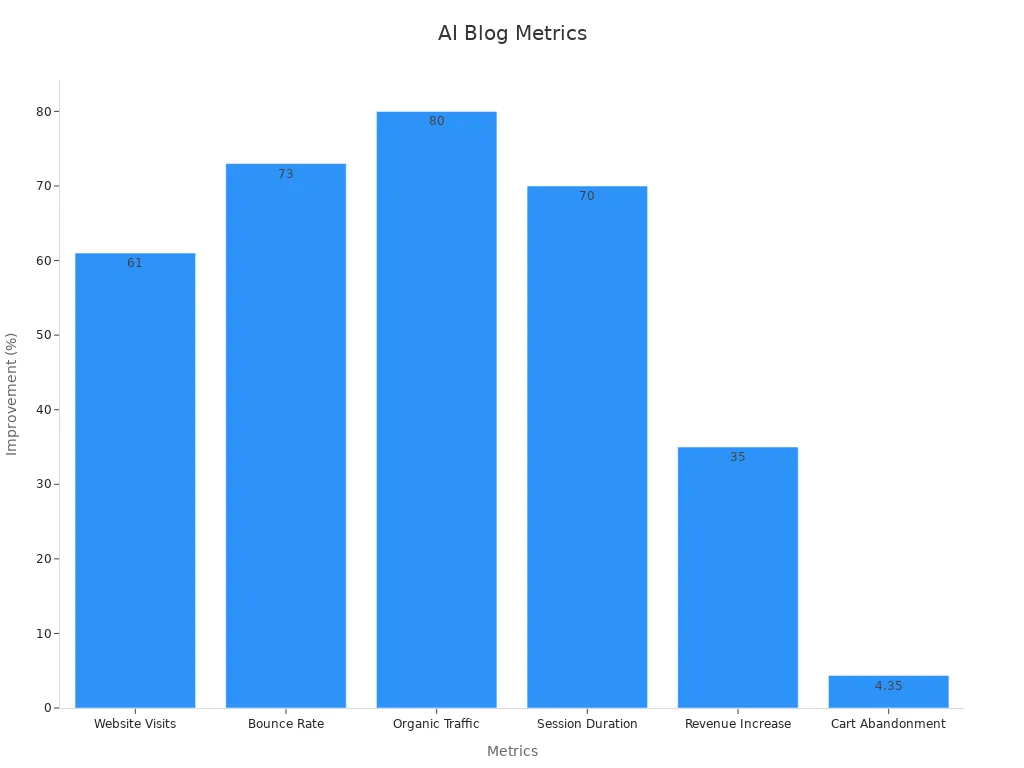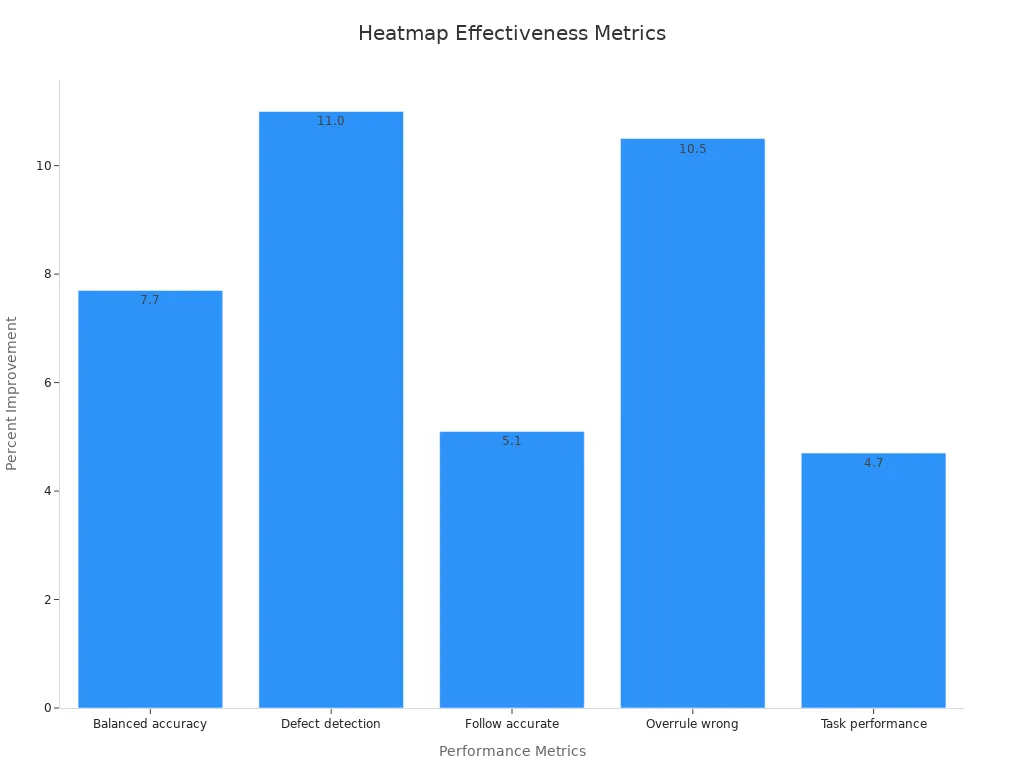Using AI to Test Blog Layout and UX

Using AI helps you test and improve blog layout and UX faster than ever before. You can run automated usability tests, get instant feedback, and spot issues early. In one study, participant accuracy in tasks improved by 34% after just a few rounds of rapid testing. Many businesses now use AI tools for real-time suggestions and predictive analytics, making it easier to fix problems and boost user satisfaction. You can combine AI with traditional testing to get the best results.
Key Takeaways
AI tools help you test your blog layout faster by tracking how users interact with your pages and giving instant feedback.
Using AI-driven testing improves user experience, boosts traffic, and increases revenue by spotting problems early and personalizing content.
Predictive heatmaps and automated usability tests let you find design issues before going live, saving time and improving accuracy.
Combining AI with traditional UX methods gives you the best insights by balancing fast data analysis with real user feedback.
Always check your AI data for accuracy and fairness to avoid bias and build trust with your readers.
Using AI for Blog UX

AI-Driven Testing
AI-driven UX testing uses smart tools to help you understand how people use your blog. These tools watch how users click, scroll, and interact with your pages. You can use AI to run automated tests, like checking if buttons work or if pages load quickly. This process gives you quick feedback, so you can fix problems right away.
AI-powered platforms like Hotjar and Microsoft Clarity show you heatmaps and user videos. These help you spot where users get stuck or leave your blog.
Chatbot testing tools, such as Cyara Botium, check if your chatbots answer questions clearly.
Accessibility tools like Pa11yNodeJS and Editoria11y make sure everyone can use your blog, including people with disabilities.
Google Lighthouse finds slow pages or broken links, so you can improve your site’s speed and reliability.
Using AI helps you collect and study lots of data fast. You can see patterns in how people use your blog. This makes it easier to make smart changes that improve user experience.
Why It Matters
When you use AI-driven testing, you make your blog better for your readers. Studies show that companies focusing on UX design see 32% higher revenue growth and 56% higher shareholder returns. For every $1 spent on UX, businesses can get $100 back. Some even see sales jump by 75% after improving UX.
Metric / Outcome | Description / Impact |
|---|---|
Website Visits | Increased by 61% with AI-driven keyword analysis |
Bounce Rate | Reduced by 73% using AI-powered navigation |
Organic Traffic | Grew by 80% with AI SEO tools |
Conversion Rates | Improved up to 4.5 times with AI recommendations |
Session Duration | 70% longer with AI personalization |
Revenue Increase | 35% higher with advanced AI personalization |
Cart Abandonment | Decreased by 4.35% with AI recommendations |
Customer Satisfaction (NPS) | Higher scores with AI chatbot engagement |
Qualified Leads | More leads generated via AI chatbots |

Using AI lets you personalize your blog for each visitor. You can adapt layouts, suggest articles, and collect feedback in real time. This keeps users engaged and helps you grow your blog faster.
AI Methods
Predictive Heatmaps
Predictive heatmaps use AI to show you where users will likely click, scroll, or focus their attention on your blog. You can upload a screenshot or mockup of your page, and the tool will highlight hot spots and cold spots. This helps you see if important buttons or links stand out. Tools like Crazy Egg and Attention Insight let you test layouts before you go live.
Tip: Predictive heatmaps help you spot problems early, so you can fix them before users get frustrated.
Domain | Task Description | Treatment Groups | Key Metrics & Results | Statistical Significance & Effect Size |
|---|---|---|---|---|
Manufacturing | Visual inspection of electronic products | Black-box AI vs Explainable AI (with heatmaps) | - Balanced accuracy: 88.6% (black-box) vs 96.3% (heatmaps) | - Balanced accuracy improvement: +7.7 percentage points (95% CI: 3.3% to 12.0%, P=0.001) |
Medical | Radiologists inspecting chest X-rays | Black-box AI vs Explainable AI (with heatmaps) | - Task performance improvement: +4.7 percentage points (95% CI: 1.1% to 8.3%, P=0.010) | - Statistically significant improvement in task performance with heatmaps |
Additional Checks | Robustness and generalizability | Non-experts (Amazon MTurk participants) | - Similar improvements in task performance metrics | - Robustness confirmed through multiple regression models and alternative metrics |

You can see that predictive heatmaps help people make better decisions and spot issues faster. This means you can improve your blog layout with more confidence.
Automated Usability Tests
Automated usability tests use AI to check how easy your blog is to use. You can set up tests that run on different devices and browsers. These tests look for broken links, slow pages, and confusing navigation. Tools like UserTesting, Testim, and Google Lighthouse let you run these tests quickly.
You upload your blog or prototype.
The tool simulates user actions, like clicking buttons or filling out forms.
You get a report with problems and suggestions.
Automated usability tests save you time. You do not need to wait for real users to find issues. You can fix problems right away and keep your blog running smoothly.
UX Audit Tools
UX audit tools powered by AI help you review your blog’s design and user experience. These tools scan your site and compare it to thousands of best practices. For example, Baymard Institute’s UX-Ray 1.0 and UX-Query use AI to answer your UX questions and give you a score based on real user testing data. You can see how your blog stacks up against top sites.
These tools give you clear steps to improve your blog. They help you focus on changes that matter most for your users. While you may not always see exact numbers for how much better your blog gets, you will notice higher user satisfaction and more conversions when you follow their advice.
AI-powered content optimization tools also show strong results. Some sites report a 43% average increase in organic traffic after using these tools for content audits and recommendations.
AI in Prototyping
AI in prototyping lets you build and test new blog layouts much faster. You can use tools like UXPin Merge or Figma’s AI plugins to create page designs with just a few clicks. These tools use smart libraries of components, so your prototypes look polished and work well.
Feedback cycles drop from days to hours.
You save months of manual work by automating UI creation.
You can export ready-to-use code, making it easy for developers to launch new features.
Teams use real user feedback to test different layouts during design sprints.
Note: Using AI in prototyping helps you try more ideas and find the best layout for your readers.
AI for UX Writing
AI for UX writing helps you create clear, helpful, and engaging content for your blog. Tools like Grammarly, Jasper, and Writer use AI to check your writing, suggest better words, and keep your tone consistent. You can also use AI to personalize messages for each reader.
AI tailors content to different stages of the user journey, helping you turn more visitors into leads.
You can measure ROI by tracking how AI-optimized content boosts revenue.
AI tools analyze brand sentiment, so you know how readers feel about your blog.
These tools keep your writing on-brand and improve quality with real-time feedback.
AI-driven SEO tools suggest keywords and help your blog rank higher in search results.
You can automate tasks like proofreading and layout, giving you more time for creative work.
AI-assisted UX writing does not replace your creativity. It supports you by making your content more effective and engaging. This leads to happier readers and better business results.
AI vs. Traditional

Key Differences
You have two main ways to test your blog’s user experience: traditional methods and AI-based methods. Each has unique strengths. The table below shows how they compare:
Factor | Traditional UX Testing | AI-Based UX Testing |
|---|---|---|
Speed | Slow, manual testing and analysis | Fast, automated, real-time processing |
Cost | High per study, needs test subjects | Higher upfront, lower per-user cost |
Accuracy | Subjective, small samples | Data-driven, scalable, less human bias |
Scalability | Small participant groups | Millions of interactions |
Processing Time | Days to weeks | Real-time analysis |
Data Volume | Dozens to hundreds of participants | Millions of interactions |
Bias | Prone to human bias | Objective, algorithmic |
Traditional UX testing uses surveys, interviews, and in-person studies. You get deep feedback from real users, but the process takes time and costs more. Using AI speeds up testing and lets you see how thousands of users interact with your blog. AI tools process data quickly and help you spot patterns that might be hard to see with manual methods.
When to Combine
You get the best results when you use both AI and traditional methods together. AI tools can make your research up to five times faster by automating note-taking, transcription, and analysis. This means you can find user behavior patterns quickly. Traditional methods give you context and deeper insights from real people.
Most organizations have not reached a high level of UX research maturity. Combining both approaches helps you make better decisions and improve your blog faster. You can use AI to handle large amounts of data and spot trends. Then, use traditional methods to understand why users behave a certain way.
Tip: Try a mixed approach. Use AI for fast, large-scale testing and traditional methods for detailed feedback. This way, you get both speed and depth in your blog UX research.
Common Concerns
Data Accuracy
You want your AI tools to give you reliable results. Data accuracy plays a big role in this process. If your data has errors or bias, your AI will make mistakes. For example, if your dataset does not include enough people from different backgrounds, your results may not work for everyone. This can lead to unfair or incorrect findings.
Dataset bias can happen when you have more data from one gender or race than another.
Social biases in your data can cause AI to repeat old mistakes.
Microsoft improved their Face API by fixing their dataset. This change reduced errors for people with different skin tones and genders.
Human oversight helps prevent “Garbage In, Garbage Out” problems. You need to check your data before using it.
You should always review your data and use both small, detailed samples and large, broad samples. This mix helps your AI make better decisions.
Sample Size
Sample size affects how well your AI understands your users. If you use a small or unbalanced sample, your AI might miss important groups. This can make your blog less helpful for some readers.
AI can find hidden groups, like occasional users who share your blog often.
Advanced tools help you pick random and fair samples.
AI models can spot non-response bias. For example, users who have not visited in 90 days may respond more than active users.
Only 20% of people donated data in one study, even though 63% said they would. This shows the gap between intent and action.
You should use dashboards to watch your data quality. Try new ways to collect data, like online surveys, to reach more users.
Ethics
Ethics matter when you use AI for UX testing. You need to make sure your AI is fair and open. Sometimes, AI works like a “black box,” making choices you cannot see or explain.
Lack of transparency can hide mistakes or bias in your AI.
Unconscious bias can enter during data labeling or algorithm design.
You should use tools that check for bias and allow you to see how decisions are made.
MIT’s DB-VEA system helps spot and fix race and gender bias in AI.
Tip: Always look for AI tools that explain their choices. This helps you build trust with your readers and fix problems quickly.
Using AI helps you test your blog faster and spot patterns that you might miss on your own. You can start by picking one AI tool for heatmaps or usability tests. Try it on a few pages and compare the results with feedback from real users. When you combine AI with traditional UX testing, you get deeper insights and more accurate improvements. Experts say this mix leads to better, user-friendly blogs. The future of blog design looks bright with these smart tools.
FAQ
How does AI help you test your blog layout?
AI tools watch how users click and scroll. You see where people get stuck or leave. This helps you fix problems fast. You can make your blog easier to use.
Can you use AI tools if you do not know how to code?
Yes! Most AI tools have simple dashboards. You upload your blog or images. The tool shows results with easy charts and tips. You do not need coding skills.
Are AI-based results always correct?
AI gives you fast feedback, but sometimes it makes mistakes. You should check the results and compare them with real user feedback. This helps you make better choices.
What is the best way to start using AI for UX testing?
Pick one AI tool, like a heatmap or usability tester.
Try it on a few pages.
Compare the results with what your readers say.
Use both AI and traditional feedback for the best results.
See Also
Transforming Blogging With AI Tools That Redefine Content Creation
Comprehensive AI Blog Builder Solutions For Hosting Writing SEO
Writesonic And QuickCreator Face Off In Content Creation Battle
Customizing Blog Posts To Suit Startup Audience Preferences Effectively
Stepwise Approach To Enhancing Mobile Responsiveness For Blogs

